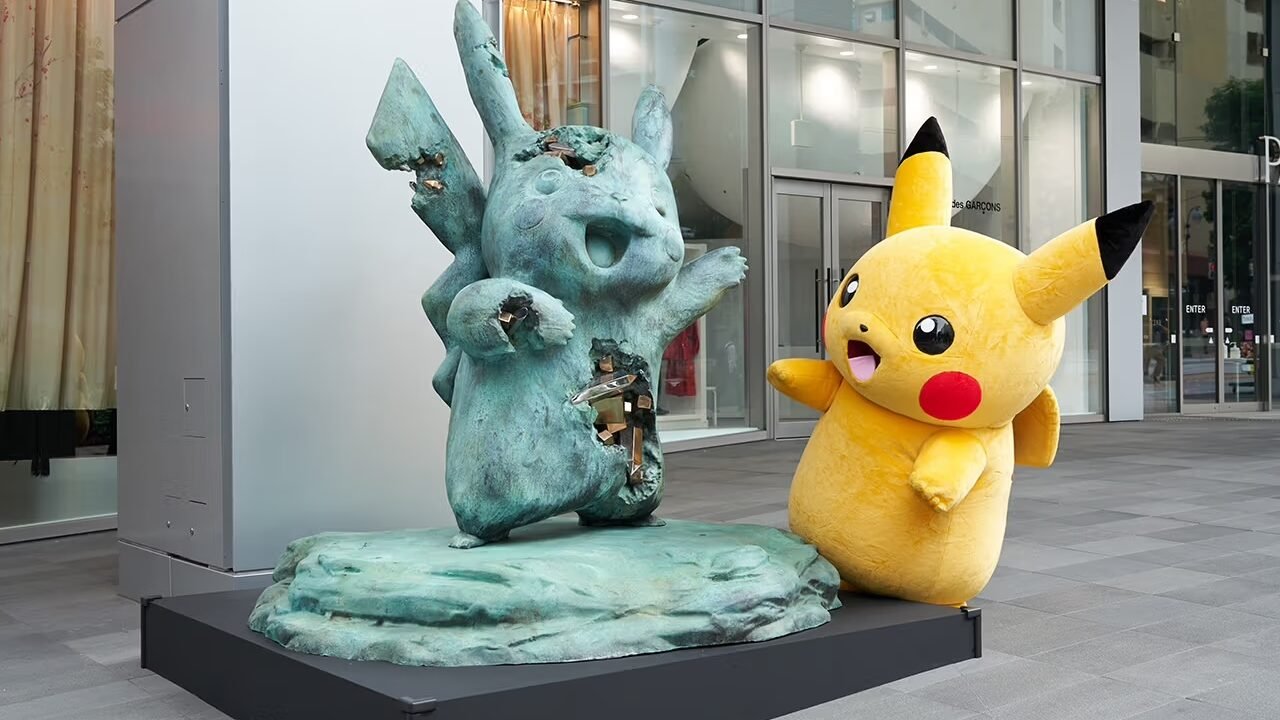

The question came to me during a recent trip to Japan when, wandering through Tokyo, I listened to a rap by the artist Takashi Murakami. Just the day before—on a Monday, with galleries closed—at an artist’s suggestion, I had visited Nakano Broadway, a mecca for manga and anime lovers, or simply for the nostalgic. There, I encountered a market frenzy I wasn’t fully aware of. While browsing vintage stores for Chanel and Louis Vuitton bags in Shibuya, I saw whole shops dedicated exclusively to Pokémon cards and figurines. Inside, the buyers weren’t kids but people my age and older, actively collecting memorabilia that tethered them to their childhoods—objects that have also acquired undeniable economic and investment value.
I was born in the 1990s. Pokémon, Digimon, Cardcaptor Sakura, Dragon Ball and countless other anime and manga didn’t just fill my childhood television programming—in Italy’s Berlusconi era, private channels like Canale 5 and Italia 1 devoted vast blocks of airtime to imported Japanese anime—but introduced me to a world of trading cards, toys, video games and every sort of gadget that could build entire imaginative and narrative universes around us. These worlds shaped not only my and my peers’ play but, I’m convinced, our imaginations and even our personalities.
In Nakano, as on previous trips to Japan, I found myself searching for that one Pokémon or Digimon figure I was missing, compelled to buy it. What drove all this was not only nostalgia but also the enduring effects of that world-building and branding—an entire cultural and narrative ecosystem sticky enough to hold our attention long after childhood.
Around the same time, the Wall Street Journal published an article by Krystal Hur highlighting how Pokémon cards have become a “hot investment,” reportedly reaching a roughly 3,821 percent cumulative return since 2004, according to an index by analytics firm Card Ladder tracking trading-card values through August. That figure eclipses even the S&P 500’s 483 percent rise over the same period or Meta Platforms’ 1,844 percent climb since going public in 2012.
The craze for the monster trading cards, first launched in 1996, apparently intensified during the pandemic after influencer Logan Paul revealed in 2022 that he had acquired a near-perfect-grade Pikachu Illustrator card worth $5.3 million, setting a Guinness World Record for the priciest Pokémon card ever sold in a private deal. Even if the exact figure is difficult to verify, the public market has its own headline records: In March 2022, Heritage Auctions sold a 1999 First Edition Holographic Charizard (PSA 10)—the iconic chase card—for $420,000. Another sold earlier this year for $175,000.
Hur’s article also featured a handful of “success stories” of thirty-somethings who now “diversify their investments” through Pokémon cards, like a 27-year-old account manager in Ohio who funded his fiancée’s 3.5-carat diamond engagement ring and part of their wedding by selling the collection he had begun in the 1990s. (How many times have I wished my mother hadn’t thrown mine away?) Yet one collector openly admitted that his buying was based less on financial calculus and more on sentiment: “A lot of us are chasing pieces of our childhood,” said Matthew Griffin.


Skeptics argue that the Pokémon card market is inconsistent and irrational because it runs largely on nostalgia and symbolic value. Others counter that it may still be safer than other pandemic-era alternative assets, like baseball cards or sports memorabilia, because fictional characters like Pikachu are timeless in a way no athlete’s career can ever be.
This brings us to a series of striking parallels—and key juxtapositions—between the Pokémon card market, other nostalgia-driven economies and today’s art market. Looking at these could reveal insights the art world can learn from Millennial and Gen X buying behavior as it struggles to attract the next generation of collectors.
Nostalgia-driven numbers
Pokémon is just one of many I.P.s that have surged in popularity among Millennial collectors, where nostalgia cycles have become engines of value creation. In recent conversations with peers across different regions—particularly in the Asia-Pacific and the U.S.—I’ve noticed a shared trend: vintage cameras, vinyl records and even relics like VHS tapes, CDs, and DVDs are becoming increasingly coveted by Millennials and Gen Z. The market for retro consoles (e.g., Nintendo 64, Game Boy, Sega Dreamcast) and the cartridges that accompanied their childhoods is booming. In July 2021, Heritage Auctions sold a sealed copy of Super Mario 64 (1996, N64) for $1.56 million—the first video game to break the million-dollar mark at auction.
A physical object tethered to an analog past now carries both aesthetic and identity value, particularly in today’s hyper-technological age. For those of us who grew up watching the dizzying curve of technological evolution unfold—from cassette to CD, from the first unlimited SMS plans to smartphones—these objects are anchors of memory and existential witnesses. The same appetite drives younger buyers toward comic books, graphic novels, vintage watches and retro fashion. Casio G-Shock, Swatch and Seiko dive watches, once essentially disposable, are now hunted down in places like Nakano Broadway or through online resellers. Fashion brands have capitalized on this by recycling Millennial childhood aesthetics tied to the 1990s—Balenciaga is a clear example. Prices for Jordan retros, Nike Dunks and Adidas Superstars are climbing, powered by ’90s and early 2000s nostalgia, while new sneaker drops sell as much on ‘I wanted these when I was 12’ as on freshness of design, as evidenced by the revivals of Puma classics or Onitsuka Tigers.


These markets operate on symbolic value, defined above all by sentiment, which is not so different from the symbolic economy that underpins art prices. Yet for these items, nostalgia—when combined with rarity and scarcity, often manufactured through limited editions, blind boxes, or surprise drops—is enough to justify soaring prices, even among Millennials who are more skeptical, more price-sensitive, and less willing to overpay. As Tim Schneider recently pointed out in The Gray Market, the greatest challenge for an art dealer today is persuading skeptical buyers that a work—especially by an artist their own age—is “good enough” to merit the price tag, at a time when everything else in life is also more expensive.
So why is this different? In the case of nostalgia-driven collectibles, memory itself becomes monetized, justifying even six-figure sales when the object is the only tangible key left to unlock it. But the real question is: What forged such powerful sentimental bonds that they hardened into identity and culture, transforming disposable childhood ephemera into adult investments?
Enduring cultural properties
Pokémon cards derive meaning from a broader franchise universe, which anchors each product within a wider narrative and cultural value. Branding has become synonymous with world-building, capable of creating enduring, authentic cultural and emotional resonance—an identitarian connection that goes far beyond simple fandom. This is the power of storytelling, of making a myth that accompanies an object. It’s a factor that the market for Pokémon trading cards shares with other collectible toys, such as LEGO, action figures, or comics tied to franchises like Star Wars or Marvel, among others.
The recent Labubu craze, which rapidly expanded from Hong Kong youth culture to the wider world—with people lining up and even fighting to collect this kawaii monstrous plush—follows the same logic. But it has already begun crossing into the art industry. During its Basel edition in June, Art Basel released a limited-edition Labubu figurine (in its signature “Basel blue”) exclusively at the Art Basel Shop. Only 100 were made, priced at SFr 200. The drop sold out immediately, and on-site whispers of flippers floating $5,000 resale offers surfaced within minutes. The current Labubu auction record is for a human-sized “giant” mint green version, which sold for around $150,552 (¥1.08 million) at a Yongle International auction in Beijing.


All these markets thrive on cults of character built through manufactured mythology, transforming into IP-based storytelling that multiplies value through merchandising. In the art world, by contrast, the focus remains primarily on artist biography and “serious” critical discourse, resistant to pop-cultural world-building and even to branding. “When you buy a Rolex from Rolex, it says Rolex; paintings from Gagosian are signed Koons or Saville,” collector Jeff Magid wrote in an opinion piece for ARTnews, addressing similar questions.
This provocation reveals how the art world continues to fall short in offering status-signaling objects—and, I would add, community belonging and recognizability—that luxury brands and contemporary collectibles have perfected. Pokémon, Labubu, sneakers and vintage collectibles (across tech, fashion and design) are unmistakable lifestyle signals. Combined with scarcity and shared rituals, they build and sustain cultural capital that can be seamlessly converted into economic capital.
Connected communities and lower buy-in barriers
Accessibility matters. Pokémon cards, Labubu and most of the collectibles markets mentioned above have achieved early onboarding because of their relative affordability. Pokémon packs or Labubu blind boxes start at $10-20, a low barrier that draws kids and teens into the narrative and the act of collecting early, setting up a long-tail trajectory to remain engaged and eventually move into higher price points as their disposable income grows. Nostalgia cycles then keep the value alive, ensuring continuity across generations.
Interestingly, in recent days, former auction-house enfant terrible Loïc Gouzer reposted on Instagram his now-iconic promo video for his cross-category curated sale, If I Live I’ll See You Tuesday…, held at Christie’s in May 2014, where he placed Basquiat next to Koons, Hirst, rare cars and sneakers for the first time in what was then a radical act. The auction was revolutionary at the time because it embraced streetwear marketing logic: drop a disruptive trailer, build hype, collapse categories and make collecting feel cool rather than fusty and exclusive.


Coming from a younger generation into the aging world of auctions, Gouzer instinctively understood the need to reinvent storytelling and branding, adopting the cultural language of younger audiences—skate videos, streetwear aesthetics, cross-genre mashups—to reframe how value was perceived. His cross-category auctions also tapped into the logic of nostalgia cycles: pairing high art with luxury toys of a different order—cars, watches, memorabilia—made the auction floor feel like a Millennial collector’s fantasy closet.
Brand dilution and cross-industry myth
Here we can return to the “illumination” sparked by discovering that Murakami had also ventured into rap, among so many other expressions of his style—or better said, of his “branding.” Takashi Murakami is arguably one of the first artists to adopt and fully integrate these dynamics, making pop-cultural world-building a core element of his aesthetics and practice. Through Kaikai Kiki, he blurred the line between fine art and merchandise. By applying his instantly recognizable, fresh, youthful style—populated by kawaii characters rooted in Japanese manga, objects, and even experiences—he pursued a pop-culture logic of world-building while embracing a degree of brand dilution that lowered barriers to entry. In this way, a teenager buying a keychain or plush mascot at ComplexCon could enter the same collector’s universe as a seasoned buyer spending millions at Gagosian or at auction on one of his monumental paintings.


Notably, Murakami didn’t invent this playbook; he absorbed a cultural logic already deeply embedded in Japanese pop culture, as his notion of “Superflat” was designed to articulate. Capsule collections, limited drops, and the collapse of boundaries between “high” and “low” have long defined Japan’s cultural and creative industries. Early streetwear pioneers like A Bathing Ape (BAPE), COMME des GARÇONS and Neighborhood built empires on scarcity and hype. At the same time, manga and anime cultivated devoted fandoms where merchandise was as central as the story itself.
By asserting that contemporary Japanese visual culture had already flattened its hierarchies, Murakami’s “Superflat-ness” offered a theoretical framework that made his fusion of fine art, commerce, and pop culture not only coherent but essential to his practice—never a compromise of artistic integrity. Even his collaborations with Louis Vuitton or Uniqlo weren’t betrayals of art but natural continuations of a Japanese cultural economy where brand, object, and fandom constantly intertwine, creating symbolic universes that buyers can both belong to and collect.
Alongside Murakami, KAWS stands as another powerful model, this time on the American side. His toys and Uniqlo collaborations have already fostered a generation of young collectors who later graduated to six-figure Companion sculptures as their first major art purchases. Daniel Arsham has played a similar game, targeting Millennial collectors with his Pokémon sculptures while building pipelines through more accessible editions and sneaker collaborations.
The series, including the gadget-inspired works, began as a formal collaboration between Daniel Arsham and The Pokémon Company, which partnered to present Relics of Kanto Through Time (2020) at the PARCO Museum Tokyo, where he reimagined Pokémon as archaeological relics unearthed a thousand years in the future. The collaboration continued with A Ripple in Time, a series of exhibitions and installations across Tokyo organized by Nanzuka that paired Arsham’s fictional-archaeology style with Pokémon lore. This phase expanded the project to include bronze sculptures, concept art, animation, and reinterpreted Pokémon cards rendered in Arsham’s signature eroded aesthetic. Most of the Pokémon sculptures were produced in extremely limited editions—99, 500, or fewer units—and distributed through raffles or lottery systems rather than web drops, creating built-in scarcity and positioning the project squarely at the intersection of art markets and collectible fandom economies.


Meanwhile, a museum like MoMA already seems attuned to both the potential and the risk of brand dilution in cross-industry collaborations. The institution recently announced a capsule collection with Mattel featuring seven products inspired by artists and artworks from MoMA’s permanent collection. The figurines range from a Van Gogh Barbie wearing an evening gown printed with Starry Night (1889) to two Little People Collector figures modeled after Monet’s
As I argued recently, cross-industry collaborations offer artists crucial gateways while cultivating new audiences. At the same time, platforms like Avant Arte are proving that there is a young, eager audience ready to engage with art—so long as editions feel authentic and accessible, and community remains central to the narrative. According to recent surveys, the global collectibles market has surpassed $496 billion in 2025. If the art world wants to avoid shrinking in both volume and financial weight as it struggles to broaden its buyer base, then making art more “collectible”—at multiple price points and across different stages of life—may be the only sustainable strategy for cultivating lifelong engagement from the next generation of buyers.











